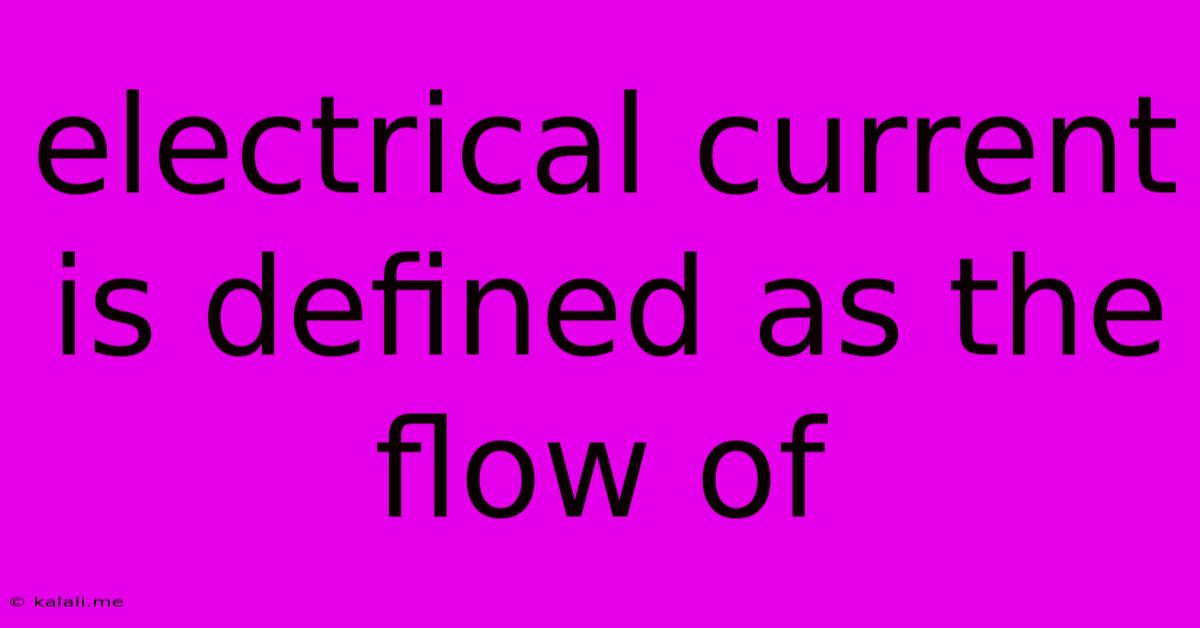Electrical Current Is Defined As The Flow Of
Kalali
Jun 16, 2025 · 3 min read

Table of Contents
Electrical Current: Defined as the Flow of Electric Charge
Electrical current, a fundamental concept in physics and electrical engineering, is defined as the flow of electric charge. This seemingly simple definition encompasses a wealth of complex phenomena, powering everything from the smallest microchips to the largest power grids. Understanding what constitutes this flow, its measurement, and its various forms is crucial to grasping the principles of electricity. This article will delve into the specifics of electrical current, exploring its nature, types, and practical applications.
What exactly is flowing? It's not electrons alone, although that's a common misconception. While electron flow is a significant component in many conductive materials like metals, the broader definition encompasses the movement of any charged particle. This could include ions (charged atoms) in electrolytes, like those found in batteries, or holes (the absence of an electron, acting as a positive charge carrier) in semiconductors. The crucial element is the net movement of charge.
Types of Electrical Current
There are two primary types of electrical current:
-
Direct Current (DC): In DC circuits, the electric charge flows in only one direction. This is the type of current produced by batteries and solar cells. DC is characterized by its constant polarity, meaning the positive and negative terminals maintain their charge consistently. DC power supplies are commonly used in electronic devices.
-
Alternating Current (AC): AC current is characterized by a periodic reversal of the direction of charge flow. The charge flows first in one direction, then reverses, repeating this cycle many times per second. The frequency of this reversal is measured in Hertz (Hz), with household electricity typically operating at 50Hz or 60Hz. AC is more efficient for long-distance power transmission.
Measuring Electrical Current
Electrical current is measured in Amperes (A), often shortened to "amps." One ampere is defined as one coulomb of charge passing a given point in one second. Ammeters, connected in series with a circuit, are used to measure the current flowing through a particular branch of the circuit. Understanding current measurements is vital for circuit analysis and ensuring the safe operation of electrical systems. Overloading a circuit with excessive current can lead to overheating and potential fire hazards.
Factors Affecting Electrical Current
Several factors influence the magnitude of electrical current in a circuit:
-
Voltage: The voltage (measured in Volts) across a circuit represents the electrical potential difference, essentially the "push" driving the charge. A higher voltage generally leads to a higher current, provided resistance remains constant.
-
Resistance: Resistance (measured in Ohms) is the opposition to the flow of current. Materials with high resistance, like insulators, impede current flow significantly, while conductors offer relatively low resistance.
-
Temperature: Temperature can influence the resistance of materials, affecting current flow. In some materials, resistance increases with temperature, while in others, it decreases.
-
Material Properties: The type of material used in the circuit plays a significant role. Metals, with their abundance of free electrons, are excellent conductors, while non-metals are typically poor conductors (insulators). Semiconductors exhibit intermediate conductivity.
Applications of Electrical Current
The flow of electrical current powers countless technologies, including:
- Lighting: Incandescent bulbs, fluorescent lights, and LEDs all rely on the passage of current to produce light.
- Heating: Electric heaters, ovens, and stovetops utilize the resistive heating effect of electrical current.
- Motors: Electric motors convert electrical energy into mechanical energy, enabling the operation of a wide range of devices from fans to vehicles.
- Electronics: Computers, smartphones, and other electronic devices function based on the controlled flow of current through intricate circuits.
In conclusion, electrical current, defined as the flow of electric charge, is a fundamental concept with far-reaching implications. Understanding its nature, types, measurement, and influencing factors is essential for anyone working with electrical systems or interested in the principles of electricity. Further exploration into circuit analysis and electronics will provide a deeper understanding of this vital phenomenon.
Latest Posts
Latest Posts
-
Reactive Power Formula In 3 Phase
Jun 16, 2025
-
Least Common Multiple Of 40 And 50
Jun 16, 2025
-
Nitrogen Used By Plants Is In The Form Of
Jun 16, 2025
-
Can You Take The Act As An Adult
Jun 16, 2025
-
What Is Unit Weight Of Water
Jun 16, 2025
Related Post
Thank you for visiting our website which covers about Electrical Current Is Defined As The Flow Of . We hope the information provided has been useful to you. Feel free to contact us if you have any questions or need further assistance. See you next time and don't miss to bookmark.